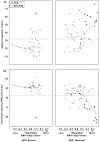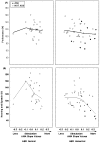Neonatal brainstem function and 4-month arousal-modulated attention are jointly associated with autism
- PMID: 23165989
- PMCID: PMC3578986
- DOI: 10.1002/aur.1259
Neonatal brainstem function and 4-month arousal-modulated attention are jointly associated with autism
Abstract
The authors evaluated the contribution of initially abnormal neonatal auditory brainstem responses (ABRs) and 4-month arousal-modulated attention visual preference to later autism spectrum disorder (ASD) behaviors in neonatal intensive care unit (NICU) graduates. A longitudinal study design was used to compare NICU graduates with normal ABRs (n = 28) to those with initially abnormal ABRs (n = 46) that later resolved. At 4 months postterm age, visual preference (measured after feeding) for a random check pattern flashing at 1, 3, or 8 Hz and gestational age (GA) served as additional predictors. Outcome measures were PDD Behavior Inventory (PDDBI) scores at 3.4 years (standard deviation = 1.2), and developmental quotients (DQ) obtained around the same age with the Griffiths Mental Development Scales (GMDS). Preferences for higher rates of stimulation at 4 months were highly correlated with PDDBI scores (all P-values < 0.01) and the GMDS Hearing and Speech DQ, but only in those with initially abnormal ABRs. Effects were strongest for a PDDBI social competence measure most associated with a diagnosis of autism. For those with abnormal ABRs, increases in preference for higher rates of stimulation as infants were linked to nonlinear increases in severity of ASD at 3 years and to an ASD diagnosis. Abnormal ABRs were associated with later reports of repetitive and ritualistic behaviors irrespective of 4-month preference for stimulation. The joint occurrence of initially abnormal neonatal ABRs and preference for more stimulation at 4 months, both indices of early brainstem dysfunction, may be a marker for the development of autism in this cohort.
© 2012 International Society for Autism Research, Wiley Periodicals, Inc.
Conflict of interest statement
The PDDBI generates a royalty for Dr. Cohen. Drs. Gardner, Karmel, Phan, Kittler, Gomez, Gonzalez, Lennon, Parab and Barone report no financial interests or potential conflicts of interest.
Figures


References
-
- Amaral DG, Bauman MD, Schumann CM. The amygdala and autism: implications from non-human primate studies. Genes, Brain and Behavior. 2003;2:295–302. - PubMed
-
- Baron-Cohen S, Ring HA, Bullmore ET, Wheelwright S, Ashwin C, Williams SC. The amygdala theory of autism. Neuroscience & Biobehavioral Reviews. 2000;24:355–364. - PubMed
-
- Bailey A, Luthert P, Dean A, Harding B, Janota I, Montgomery M, et al. A clinicopathological study of autism. Brain. 1998;121 ( Pt 5):889–905. - PubMed
-
- Bauman M, Kemper TL. Histoanatomic observations of the brain in early infantile autism. Neurology. 1985;35:866–874. - PubMed
Publication types
MeSH terms
Grants and funding
LinkOut - more resources
Full Text Sources
Medical

